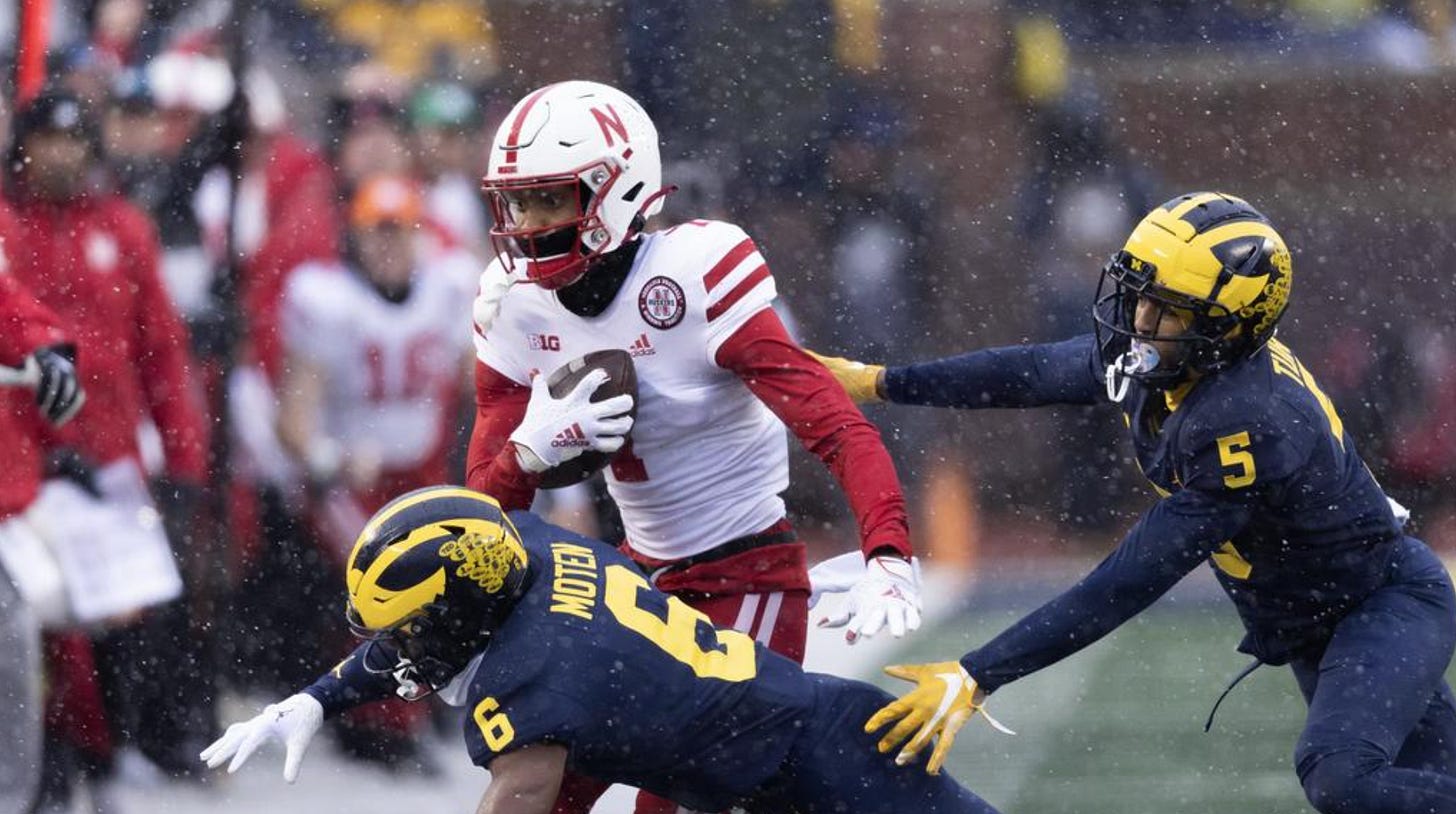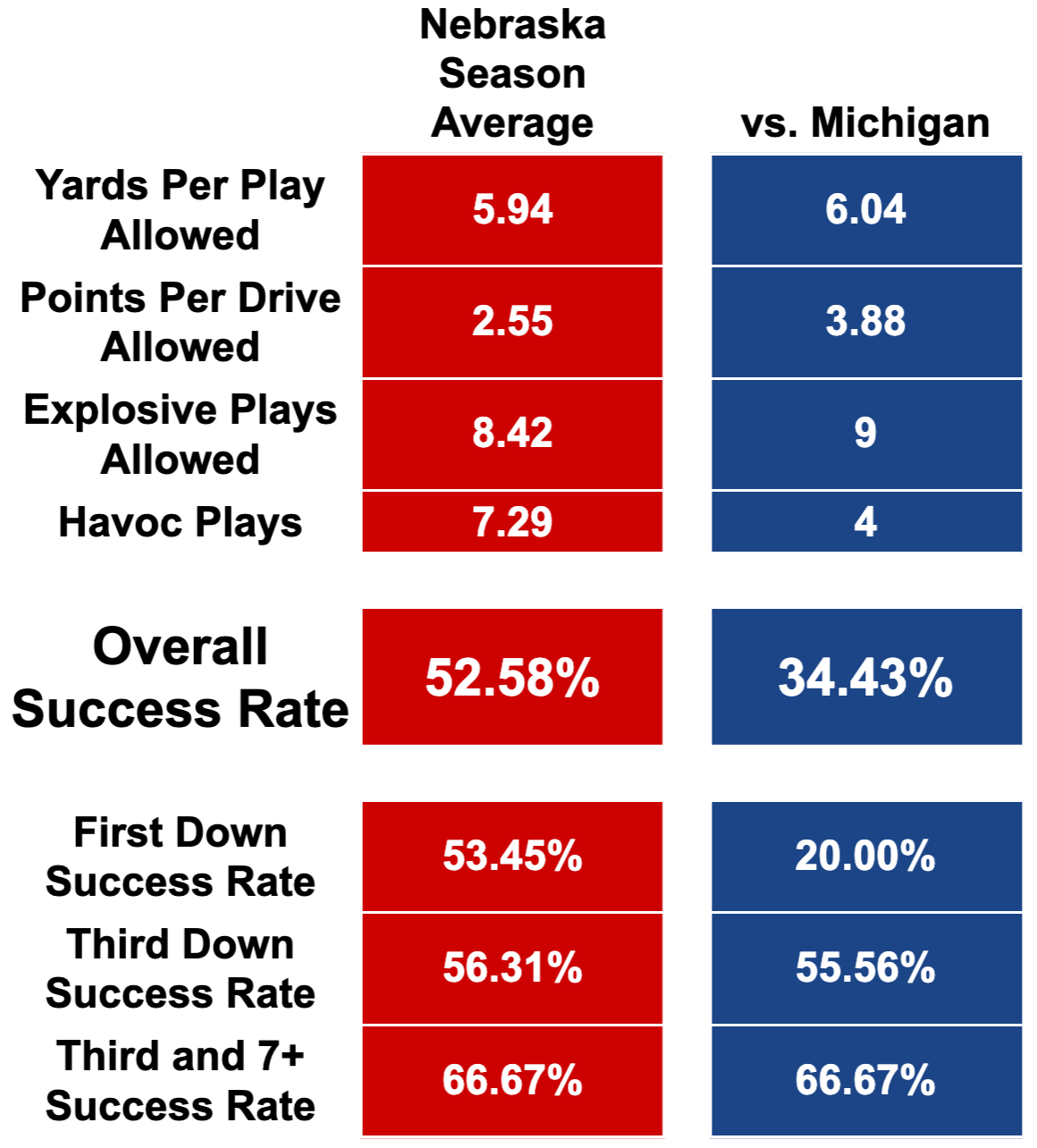2022 MICHIGAN RECAP: Let's Get This Over With
Huskers get trucked in a game no one expected them to play well in
One of these teams is very good. The other is very bad. That by itself would be enough to expect a blowout, but throw in that the bad team was playing without its quarterback, several offensive linemen, and one of its best defensive players — plus trudging through a wake for yet another failed head coaching tenure and season — and you had the recipe for a SUPER BLOWOUT. Most NU fans I knew were just hoping the doors didn’t get blown off.
That did and didn’t happen. Nebraska kept the score close early with a couple opportune defensive plays and some Michigan mistakes, while still very clearly getting run over on both sides of the ball. Things opened up a lot more in the second half as the Wolverines stopped toying with their food, but it also wasn’t a 50- or 70-pointer.
I don’t speak for everyone, but I’ve generally felt like these last couple games have been a slog, and the two upcoming seem completely miserable. I’ll watch and care because I always do and always will, but this season’s dead and the sooner we bury this and start the next era, the better.
PROGRAMMING NOTE: I had some videos breaking down the backup quarterbacks’ play for this post, but I hit some snags with my Vimeo account and am unable to create .gifs anymore? I’ll try to get this fixed before next week, but if this post seems dry … that’s why. If you’re a new subscriber, I would suggest reading the post detailing the newsletter’s plan for this year; it will better explain things like success rate and what the numbers are trying to accomplish.
OFFENSE
GAME CHART
2022 Michigan Offensive Game Chart
OVERALL
This was Nebraska’s worst offensive game of the season so far, which makes sense considering it was starting a backup quarterback with no discernible processing ability against one of the best defenses in the country. NU’s offense has struggled with per-play efficiency through most of Big Ten play but has been buoyed by big explosives; those were almost nonexistent against Michigan due to some combination of a good pass rush, good coverage, or quarterbacks wigging out before any downfield plays developed. Nebraska’s struggles on first down put it bad situations on third downs it wasn’t able to get itself out of; it didn’t convert a single third down of 7 yards or longer in six attempts.
During the game, I felt Nebraska should be running the ball more than it was, as it seemed their drives were staying on track a bit better when Grant was involved, but the numbers say the opposite. NU came out in quads formations on three of its first seven plays and then didn’t run one again until its final snap. Offensive coordinator Mark Whipple has done this several times this year, using a lot of 4x1 alignments early and then going away from them later in games. They didn’t work Saturday — almost nothing did on offense — but over the season, they’ve been far-and-away Nebraska’s most successful alignment. You can’t run quads all that often before its efficiency goes away, but I think he needs to crank this dial a little higher than he has right now.
RUNNING GAME
Michigan was not devoting many defensive resources to stopping the run game, relying on its front four to kick Nebraska’s ass up front (IT DID). It only really went to a heavy box when Nebraska was in its heavy offensive personnel, and even then, it wasn’t totally matching: Nebraska had multiple tight ends or backs on the field for 43.18% of its snaps, while Michigan only had 7 or more players in the box on 31.25% of its snaps.
Nebraska has continued to use outside zone (an off-tackle zone running play) at a higher rate as the season has progressed and after Scott Frost was removed from the offensive gameplanning. NU ran a play with an outside zone element on just five snaps in the three games with Frost involved, but in the games since his firing it has now become NU’s third most common run concept. I’m not quite sure why, as it’s been among their least effective runs: NU’s outside zone run plays have a success rate of 24.24% this year, while duo and inside zone (run concepts that hit in the A and B gaps and the only two concepts NU is using more than outside zone) this season are both around a 50% success rate. It also doesn’t match with Nebraska’s personnel — Anthony Grant is an interior zone running savant but doesn’t have great speed, something that makes running outside zone easier. This usage feels like Whipple running what he wants to as opposed to what fits his roster or experienced talent.
We also saw a much higher use of run reads and triple option concepts with both of the backup quarterbacks, especially with Logan Smothers in the game. Smothers is one of the fastest players on the team and has an arm that could generously be described as … not strong … so that tracks they would try to do that more with him. I just wish they’d do it more in the normal game flow, too.
PASSING GAME
Whipple did try to make things easier on the backups by running about 11% more quick game than typical; eliminating the riskier deep-drop, seven-man protection concepts that he had been running with Casey Thompson; and moving the quarterback more on boots and rollouts, which gives a quarterback an easier read because they’re only selecting from the half of the field they are rolling to. I’d like to have seen more play-action — play-action is essentially an easy button for quarterbacks, even if the running game isn’t being effective — but he seems intrinsically averse to incorporating play-action in any meaningful way.
It’s also worth noting Michigan blitzed the hell out of both backup quarterbacks, sending pressure or running a game on almost half of the Huskers’ dropbacks, about nine percent higher than an already-high rate against Thompson. NU actually had more success against UM blitzes than it did against the standard rush, mostly due to a handful of good scrambles and because the Michigan secondary was winning its individual battles almost every down (blitzing was exposing holes in the coverage that weren’t there in the standard shell.
I actually thought Saturday was actually an OK day from the offensive line in pass protection. Michigan generated some pressure, but a good chunk of it was caused by NU’s quarterbacks not stepping up into clean pockets or losing their minds and scrambling into rushers.
While on the QBs … Chubba Purdy does not look ready to be playing Big Ten football. He has no discernible process, isn’t reading coverages, lacks awareness of when to step into the pocket, and isn’t setting his feet or drops on throws. Logan Smothers is not as physically talented a passer but at least seems to sticking to fundamentals when he plays, which you can work with. I don’t know if Purdy is just the best practice player of all-time or something, but his game performance has been just him playing backyard ball. His good plays in the spring game were out of structure, too. It may be moot, as Purdy left the Michigan game early with injury, but why Smothers isn’t taking all of the snaps until Thompson returns is beyond me.
I was interested to see how the play selection changed in the last two games with full weeks to gameplan around playing with a new quarterback. The answer is … not much. Nebraska ran more flood concepts (a layered three-level concept with a vertical route, a deep out-breaking route and a flat route) than normal, but that was largely to attack Michigan’s heavy-Cover 3 coverage structure (UM played Cover 3 on 41.7% of Nebraska’s passing downs.) Other than that, it was a lot of the same shallow middle drag routes with layers behind them that Whipple favors. This is one of the most boring offenses on the planet.
DEFENSE
GAME CHART
2022 Michigan Defensive Game Chart
OVERALL
Anyone who watched saw the down-by-down success Michigan was having, especially running the ball, and the numbers bear that out. Only preventing your opponent from gaining less than five yards on a fifth of your first downs is not going to lead to a good defensive performance. Nebraska probably got some breaks to have such a good third down numbers; if you’re bad on first down you’re typically also bad on third down, so for those rates to be 35 percentage points apart tells me the Blackshirts were catching some breaks.
The defensive story of this game was Michigan mauling the Blackshirts when they went into heavy offensive personnels with multiple tight ends. It shows up in almost every statistical area of this game:
Nebraska had been using less and less base defense since Bill Busch took over as coordinator but used it on over half its snaps — largely to match Michigan’s personnel and slow the ground game — but the Wolverines were successful on nearly 75 percent of their plays against Nebraska’s base personnel;
Michigan was successful on almost 75% of (a) its pure running plays and (b) on running and passing plays against boxes of 7 players or more;
NU ran single-high safety coverages (Cover 1 and Cover 3) 44 times Saturday and was successful on just 17. Single-high coverages are a common answer to stopping running games because they allow you to get another defender in the box, which UM torched through the run and the pass.
But for as bad as ugly as the run defense was, the Blackshirts were not atrocious against the pass. Nebraska’s nickel group actually outperformed the Michigan offense when it was on the field on a per-snap basis, and Michigan’s pure passing plays generated a 48% success rate (though their successful plays were VERY successful). Some of this was UM missing passes — their QB did not seem to be his sharpest Saturday — but Nebraska’s secondary also won some battles, and the plan under Busch has been much more sound. The Cover 1-heavy strategy is still risky, but it also makes teams have to execute in the passing game to beat you, and Michigan struggled with that. Teams keep picking on true freshman Malcolm Hartzog (and I keep waiting for him to get torched) but he keeps making plays.
For that reason, I actually thought this was a pretty solid and valiant effort by the Blackshirts; Michigan is just a lot more talented and physical than Nebraska. They obviously got torched by the UM running game, but this was the same group that was giving up 700 yards to Georgia Southern, and now they are at least occasionally causing one of the best offenses in the country some headaches. This unit has improved; the starting point was just so bad that improvement is getting the unit to playing below average ball.
Thanks, as always, for reading. I’m going to attempt to haul through the Wisconsin breakdown to get it out to people in time for them to read it during holiday travel, but they do take me a while, so no guarantees! GBR.












